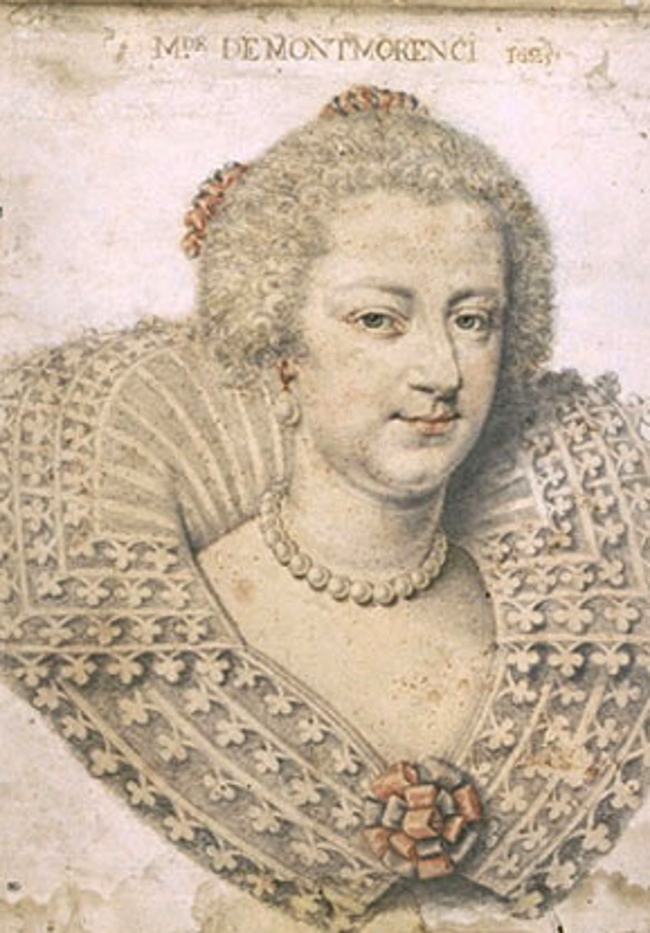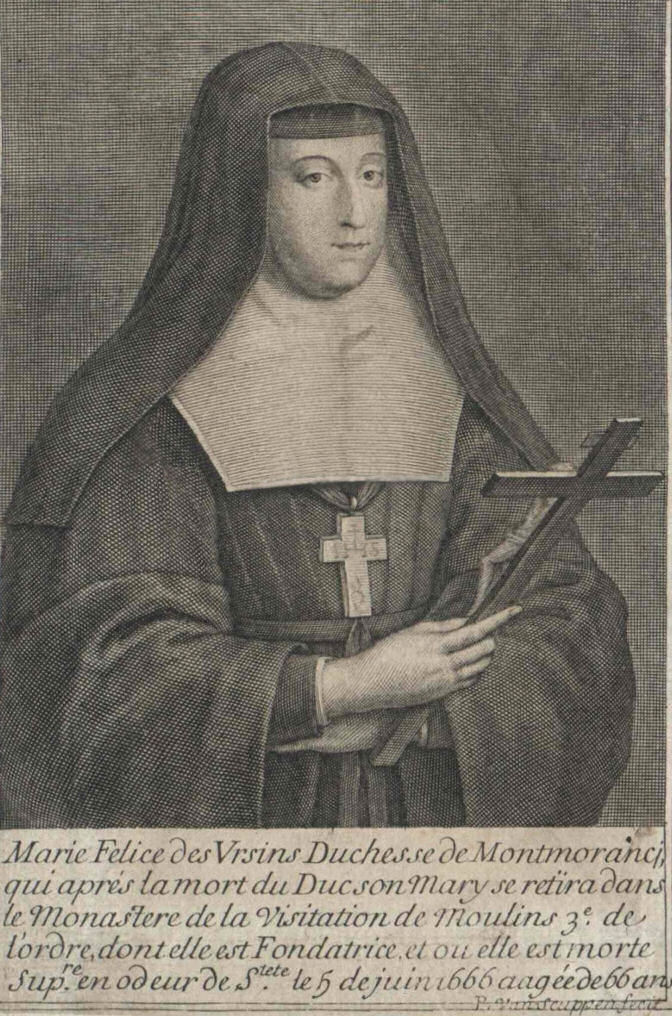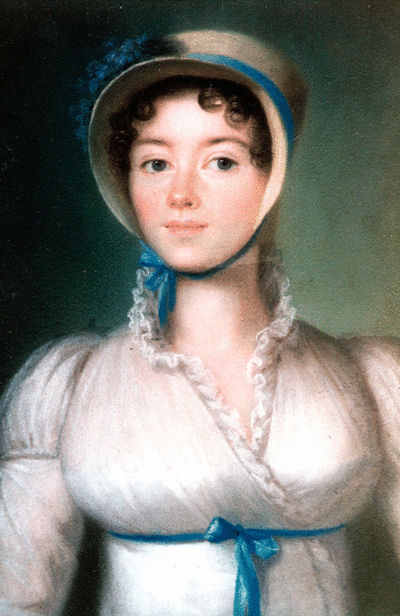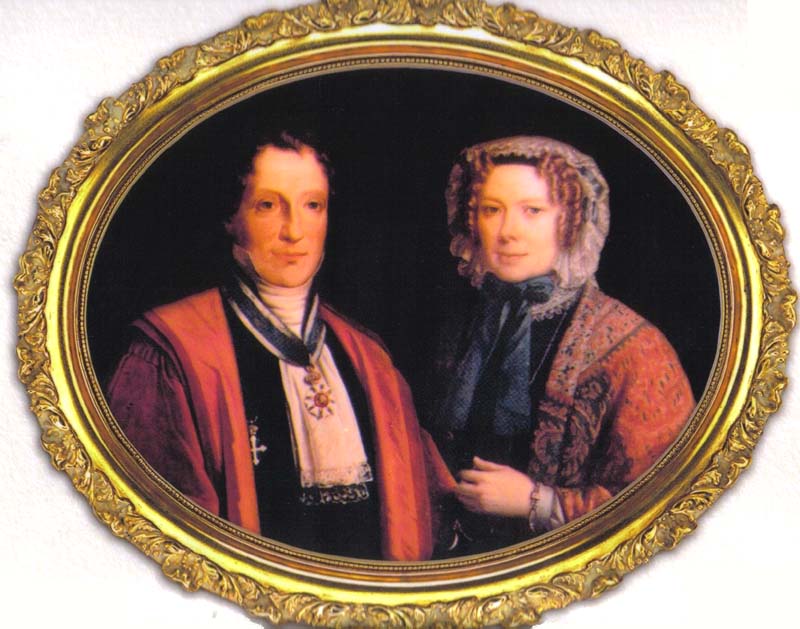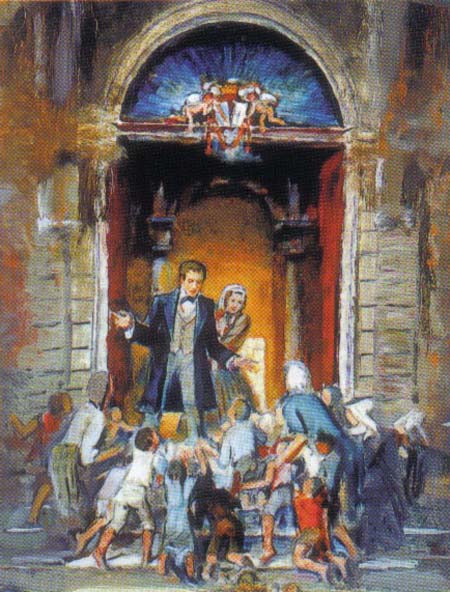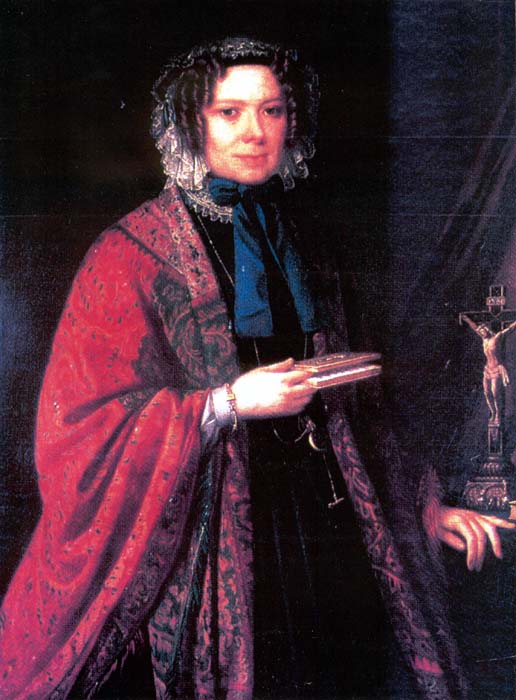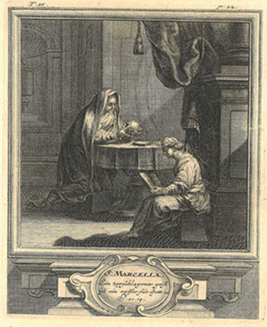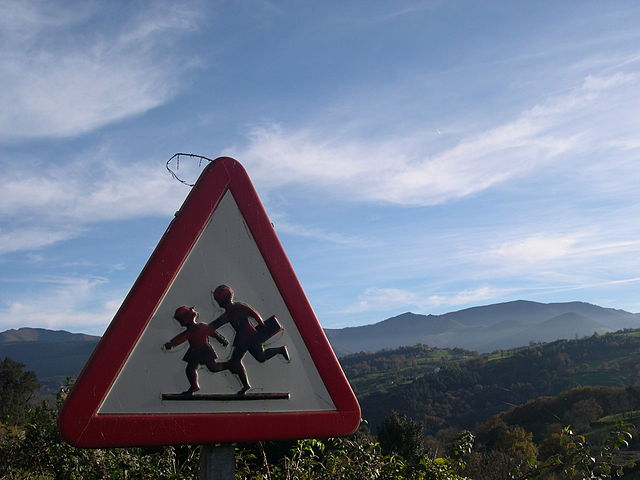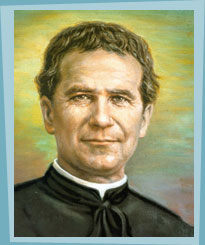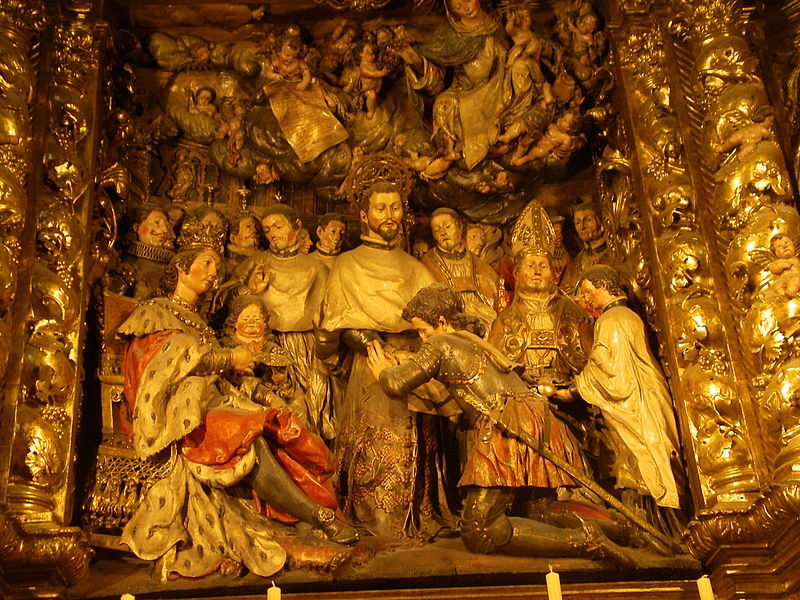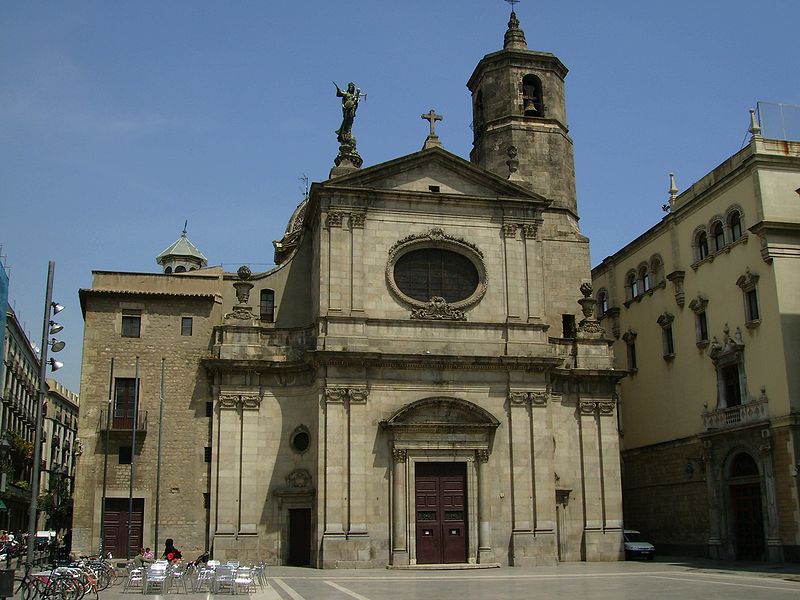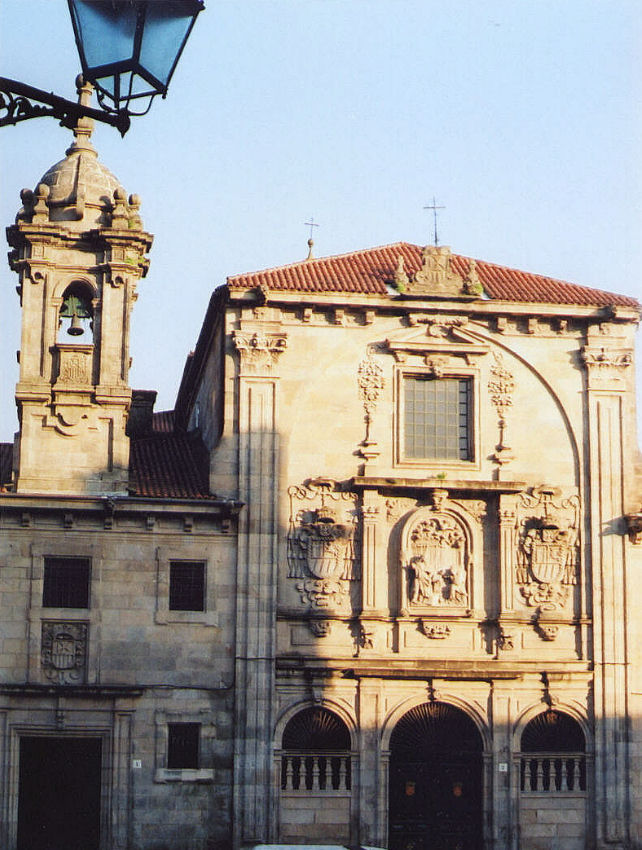
Charlemagne
(French for Charles the Great, Carolus Magnus, or Carlus Magnus; German Karl der Grosse).
The name given by later generations to Charles, King of the Franks, first sovereign of the Christian Empire of the West; born 2 April, 742; died at Aachen, 28 January, 814.
At the time of Charles’ birth, his father, Pepin the Short, Mayor of the Palace, of the line of Arnulf, was, theoretically, only the first subject of Childeric III, the last Merovinigian King of the Franks; but this modest title implied that real power, military, civil, and even ecclesiastical, of which Childeric’s crown was only the symbol. It is not certain that Bertrada (or Bertha), the mother of Charlemagne, a daughter of Charibert, Count of Laon, was legally married to Pepin until some years later than either 742 or 745.
Charlemagne’s career led to his acknowledgment by the Holy See as its chief protector and coadjutor in temporals, by Constantinople as at least Basileus of the West. This reign, which involved to a greater degree than that of any other historical personage the organic development, and still more, the consolidation of Christian Europe, will be sketched in this article in the successive periods into which it naturally divides. The period of Charlemagne was also an epoch of reform for the Church in Gaul, and of foundation for the Church in Germany, marked, moreover, by an efflorescence of learning which fructified in the great Christian schools of the twelfth and later centuries.
To the Fall of Pavia (742-774)
In 752, when Charles was a child of not more than ten years, Pepin the Short had appealed to Pope Zachary to recognize his actual rule with the kingly title and dignity. The practical effect of this appeal to the Holy See was the journey of Stephen III across the Alps two years later, for the purpose of anointing with the oil of kingship not only Pepin, but also his son Charles and a younger son, Carloman. The pope then laid upon the Christian Franks a precept, under the gravest spiritual penalties, never “to choose their kings from any other family”. Primogeniture did not hold in the Frankish law of succession; the monarchy was elective, though eligibility was limited to the male members of the one privileged family. Thus, then, at St. Denis on the Seine, in the Kingdom of Neustria, on the 28th of July, 754, the house of Arnulf was, by a solemn act of the supreme pontiff established upon the throne until then nominally occupied by the house of Merowig (Merovingians).
Charles, anointed to the kingly office while yet a mere child, learned the rudiments of war while still many years short of manhood, accompanying his father in several campaigns. This early experience is worth noting chiefly because it developed in the boy those military virtues which, joined with his extraordinary physical strength and intense nationalism, made him a popular hero of the Franks long before he became their rightful ruler. At length, in September, 768, Pepin the Short, foreseeing his end, made a partition of his dominions between his two sons. Not many days later the old king passed away.
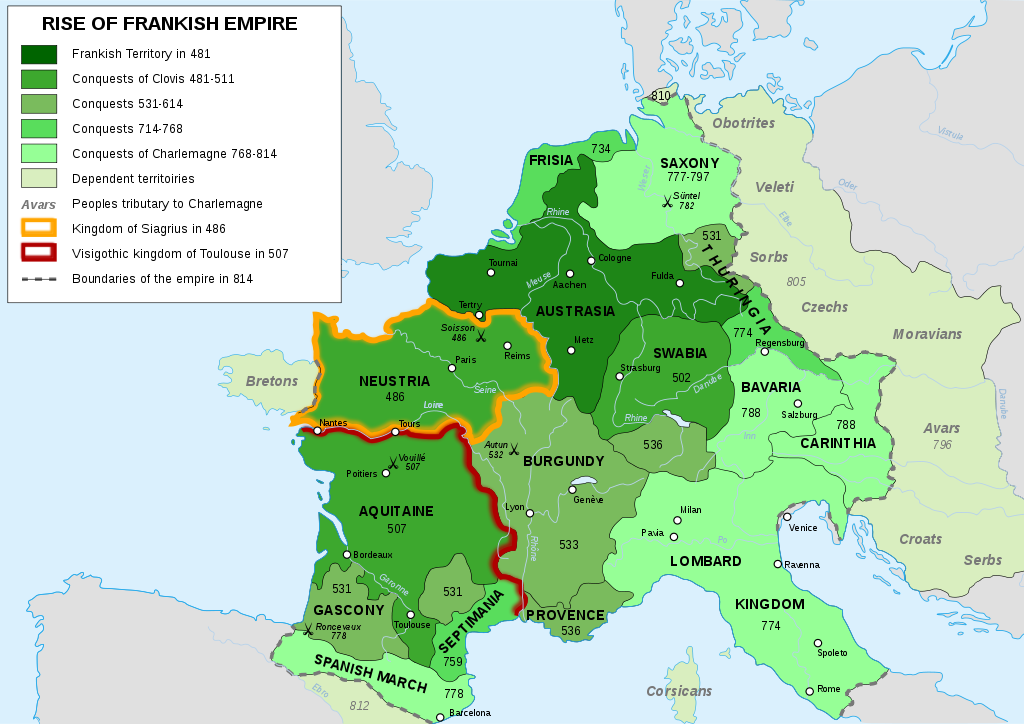
Map of the rise of Frankish Empire, from 481 to 814, by Sémhur
To better comprehend the effect of the act of partition under which Charles and Carloman inherited their father’s dominions, as well as the whole subsequent history of Charles’ reign, it is to be observed that those dominions comprised:
- first, Frankland (Frankreich) proper;
- secondly, as many as seven more or less self-governing dependencies, peopled by races of various origins and obeying various codes of law.
Of these two divisions, the former extended, roughly speaking, from the boundaries of Thuringia, on the east, to what is now the Belgian and Norman coastline, on the west; it bordered to the north on Saxony, and included both banks of the Rhine from Cologne (the ancient Colonia Agrippina) to the North Sea; its southern neighbours were the Bavarians, the Alemanni, and the Burgundians. The dependent states were: the fundamentally Gaulish Neustria (including within its borders Paris), which was, nevertheless, well leavened with a dominant Frankish element; to the southwest of Neustria, Brittany, formerly Armorica, with a British and Gallo-Roman population; to the south of Neustria the Duchy of Aquitaine, lying, for the most part, between the Loire and the Garonne, with a decidedly Gallo-Roman population; and east of Aquitaine, along the valley of the Rhone, the Burgundians, a people of much the same mixed origin as those of Aquitaine, though with a large infusion of Teutonic blood.
These States, with perhaps the exception of Brittany, recognized the Theodosian Code as their law. The German dependencies of the Frankish kingdom were Thuringia, in the valley of the Main, Bavaria, and Alemannia (corresponding to what was later known as Swabia). These last, at the time of Pepin’s death, had but recently been won to Christianity, mainly through the preaching of St. Boniface. The share which fell to Charles consisted of all Austrasia (the original Frankland), most of Neustria, and all of Aquitaine except the southeast corner. In this way the possessions of the elder brother surrounded the younger on two sides, but on the other hand the distribution of races under their respective rules was such as to preclude any risk of discord arising out of the national sentiments of their various subjects.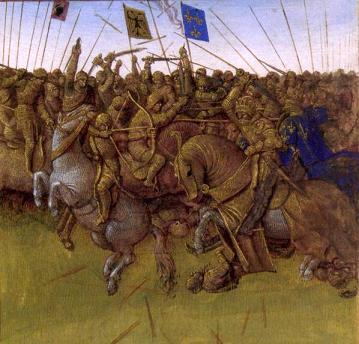
In spite of this provident arrangement, Carloman contrived to quarrel with his brother. Hunald, formerly Duke of Aquitaine, vanquished by Pepin the Short, broke from the cloister, where he had lived as a monk for twenty years, and stirred up a revolt in the western part of the duchy. By Frankish custom Carloman should have aided Charles; the younger brother himself held part of Aquitaine; but he pretended that, as his dominion were unaffected by this revolt, it was no business of his. Hunald, however, was vanquished by Charles single-handed; he was betrayed by a nephew with whom he had sought refuge, was sent to Rome to answer for the violation of his monastic vows, and at last, after once more breaking cloister, was stoned to death by the Lombards of Pavia.
For Charles the true importance of this Aquitanian episode was in its manifestation his brother’s unkindly feeling in his regard, and against this danger he lost no time in taking precautions, chiefly by winning over to himself the friends whom he judged likely to be most valuable; first and foremost of these was his mother, Bertha, who had striven both earnestly and prudently to make peace between her sons, but who, when it became necessary to take sides with one or the other could not hesitate in her devotion to the elder. Charles was an affectionate son; it also appears that, in general, he was helped to power by his extraordinary gift of personal attractiveness.
Carloman died soon after this (4 December, 771), and a certain letter from “the Monk Cathwulph”, quoted by Bouquet (Recueil. hist., V, 634), in enumerating the special blessings for which the king was in duty bound to be grateful, says,
Third . . . God has preserved you from the wiles of your brother . . . . Fifth, and not the least, that God has removed your brother from this earthly kingdom.
Carloman may not have been quite so malignant as the enthusiastic partisans of Charles made him out, but the division of Pepin’s dominions was in itself an impediment to the growth of a strong Frankish realm such as Charles needed for the unification of the Christian Continent. Although Carloman had left two sons by his wife, Gerberga, the Frankish law of inheritance gave no preference to sons as against brother; left to their own choice, the Frankish lieges, whether from love of Charles or for the fear which his name already inspired, gladly accepted him for their king. Gerberga and her children fled to the Lombard court of Pavia. In the mean while complications had arisen in Charles’ foreign policy which made his newly established supremacy at home doubly opportune.
From his father Charles had inherited the title “Patricius Romanus” which carried with it a special obligation to protect the temporal rights of the Holy See. The nearest and most menacing neighbour of St. Peter’s Patrimony was Desidarius (Didier), King of the Lombards, and it was with this potentate that the dowager Bertha had arranged a matrimonial alliance for her elder son. The pope had solid temporal reasons for objecting to this arrangement. Moreover, Charles was already, in foro conscientiae, if not in Frankish law, wedded to Himiltrude. In defiance of the pope’s protest (PL 98:250), Charles married Desiderata, daughter of Desiderius (770), three years later he repudiated her and married Hildegarde, the beautiful Swabian. Naturally, Desiderius was furious at this insult, and the dominions of the Holy See bore the first brunt of his wrath.
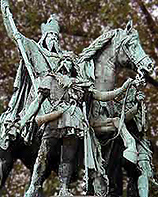
To battle
But Charles had to defend his own borders against the heathen as well as to protect Rome against the Lombard. To the north of Austrasia lay Frisia, which seems to have been in some equivocal way a dependency, and to the east of Frisia, from the left bank of the Ems (about the present Holland-Westphalia frontier), across the valley of the Weser and Aller, and still eastward to the left bank of the Elbe, extended the country of the Saxons, who in no fashion whatever acknowledged any allegiance to the Frankish kings. In 772 these Saxons were a horde of aggressive pagans offering to Christian missionaries no hope but that of martyrdom; bound together, normally, by no political organization, and constantly engaged in predatory incursions into the lands of the Franks.
Their language seems to have been very like that spoken by the Egberts and Ethelreds of Britain, but the work of their Christian cousin, St. Boniface, had not affected them as yet; they worshipped the gods of Walhalla, united in solemn sacrifice — sometimes human — to Irminsul (Igdrasail), the sacred tree which stood at Eresburg, and were still slaying Christian missionaries when their kinsmen in Britain were holding church synods and building cathedrals. Charles could brook neither their predatory habits nor their heathenish intolerance; it was impossible, moreover, to make permanent peace with them while they followed the old Teutonic life of free village communities.
He made his first expedition into their country in July, 772, took Eresburg by storm, and burned Irminsul. It was in January of this same year that Pope Stephen III died, and Adrian I, an opponent of Desiderius, was elected. The new pope was almost immediately assailed by the Lombard king, who seized three minor cities of the Patrimony of St. Peter, threatened Ravenna itself, and set about organizing a plot within the Curia. Paul Afiarta, the papal chamberlain, detected acting as the Lombard’s secret agent, was seized and put to death. The Lombard army advanced against Rome, but quailed before the spiritual weapons of the Church, while Adrian sent a legate into Gaul to claim the aid of of the Patrician.
Thus it was that Charles, resting at Thionville after his Saxon campaign, was urgently reminded of the rough work that awaited his hand south of the Alps. Desiderius’ embassy reached him soon after Adrian’s. He did not take it for granted that the right was all upon Adrian’s side; besides, he may have seen here an opportunity make some amends for his repudiation of the Lombard princess. Before taking up arms for the Holy See, therefore, he sent commissioners into Italy to make enquiries and when Desiderius pretended that the seizure of the papal cities was in effect only the legal foreclosure of a mortgage, Charles promptly offered to redeem them by a money payment. But Desiderius refused the money, and as Charles’ commissioners reported in favour of Adrian, the only course left was war.
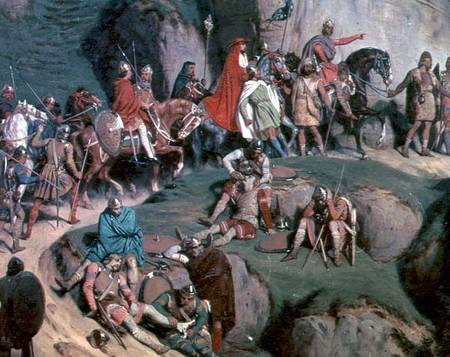
Charlemagne's army crossed the Alps with amazing speed
In the spring of 773 Charles summoned the whole military strength of the Franks for a great invasion of Lombardy. He was slow to strike, but he meant to strike hard. Data for any approximate estimate of his numerical strength are lacking, but it is certain that the army, in order to make the descent more swiftly, crossed the Alps by two passes: Mont Cenis and the Great St. Bernard. Einhard, who accompanied the king over Mont Cenis (the St. Bernard column was led by Duke Bernhard), speaks feelingly of the marvels and perils of the passage. The invaders found Desiderius waiting for them, entrenched at Susa; they turned his flank and put the Lombard army to utter rout. Leaving all the cities of the plains to their fate, Desiderius rallied part of his forces in Pavia, his walled capital, while his son Adalghis, with the rest, occupied Verona. Charles, having been joined by Duke Bernhard, took the forsaken cities on his way and then completely invested Pavia (September, 773), whence Otger, the faithful attendant of Gerberga, could look with trembling upon the array of his countrymen. Soon after Christmas Charles withdrew from the siege a portion of the army which he employed in the capture of Verona. Here he found Gerberga and her children; as to what became of them, history is silent; they probably entered the cloister.
What history does record with vivid eloquence is the first visit of Charles to the Eternal City. There everything was done to give his entry as much as possible the air of a triumph in ancient Rome. The judges met him thirty miles from the city; the militia laid at the feet of their great patrician the banner of Rome and hailed him as their imperator. Charles himself forgot pagan Rome and prostrated himself to kiss the threshold of the Apostles, and then spent seven days in conference with the successor of Peter. It was then that he undoubtedly formed many great designs for the glory of God and the exaltation of Holy Church, which, in spite of human weaknesses and, still more, ignorance, he afterwards did his best to realize. His coronation as the successor of Constantine did not take place until twenty-six years later, but his consecration as first champion of the Catholic Church took place at Easter, 774.

Iron Crown of Lombardy. Photo by James Steakley
Soon after this (June, 774) Pavia fell, Desiderius was banished, Adalghis became a fugitive at the Byzantine court, and Charles, assuming the crown of Lombardy, renewed to Adrian the donation of of territory made by Pepin the Short after his defeat of Aistulph. (This donation is now generally admitted, as well as the original gift of Pepin at Kiersy in 752. The so-called “Privilegium Hadriani pro Carolo” granting him full right to nominate the pope and to invest all bishops is a forgery.)
To the Baptism of Wittekind (774-785)
The next twenty years of Charles’ life may be considered as one long warfare. They are filled with an astounding series of rapid marches from end to end of a continent intersected by mountains, morasses, and forests, and scantily provided with roads. It would seem that the key to his long series of victories, won almost as much by moral ascendancy as by physical or mental superiority, is to be found in the inspiration communicated to his Frankish champion by Pope Adrian I. Weiss (Weltgesch., 11, 549) enumerates fifty-three distinct campaigns of Charlemagne; of these it is possible to point to only twelve or fourteen which were not undertaken principally or entirely in execution of his mission as the soldier and protector of the Church. In his eighteen campaigns against the Saxons Charles was more or less actuated by the desire to extinguish what he and his people regarded as a form of devil-worship, no less odious to them than the fetishism of Central Africa is to us.
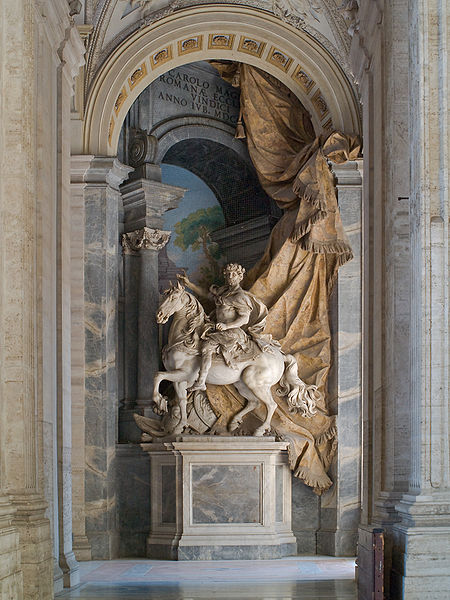
Monumental equestrian statue of Charlemagne, by Agostino Cornacchini (1725) — St. Peter's Basilica, Vatican. Photo by Myrabella.
While he was still in Italy the Saxons, irritated but not subdued by the fate of Eresburg and of Irminsul had risen in arms, harried the country of the Hessian Franks, and burned many churches; that of St. Boniface at Fritzlar, being of stone, had defeated their efforts. Returning to the north, Charles sent a preliminary column of cavalry into the enemy’s country while he held a council of the realm at Kiersy (Quercy) in September, 774, at which it was decided that the Saxons (Westfali, Ostfali, and Angrarii) must be presented with the alternative of baptism or death. The northeastern campaigns of the next seven years had for their object a conquest so decisive as to make the execution of this policy feasible. The year 775 saw the first of a series of Frankish military colonies, on the ancient Roman plan established at Sigeburg among the Westfali. Charles next subdued, temporarily at least, the Ostali, whose chieftain, Hessi, having accepted baptism, ended his life in the monastery of Fulda. Then, a Frankish camp at Lübbecke on the Weser having been surprised by the Saxons, and its garrison slaughtered, Charles turned again westward, once more routed the Westfali, and received their oaths of submission.
At this stage (776) the affairs of Lombardy interrupted the Saxon crusade. Areghis of Beneventum, son-in-law of the vanquished Desiderius, had formed a plan with his brother-in-law Adalghis (Adelchis), then an exile at Constantinople, by which the latter was to make a descent upon Italy, backed by the Eastern emperor; Adrian was at the same time involved in a quarrel with the three Lombard dukes, Reginald of Clusium, Rotgaud of Friuli, and Hildebrand of Spoleto. The archbishop of Ravenna, who called himself “primate” and “exarch of Italy”, was also attempting to found an independent principality at the expense of the papal state but was finally subdued in 776, and his successor compelled to be content with the title of “Vicar” or representative of the pope. The junction of the aforesaid powers, all inimical to the pope and the Franks, while Charles was occupied in Westphalia, was only prevented by the death of Constantine Copronymus in September, 775. After winning over Hildebrand and Reginald by diplomacy, Charles descended into Lombardy by the Brenner Pass (spring of 776), defeated Rotgaud, and leaving garrisons and governors, or counts (comites), as they were termed, in the reconquered cities of the Duchy of Friuli, hastened back to Saxony. There the Frankish garrison had been forced to evacuate Eresburg, while the siege of Sigeburg was so unexpectedly broken up as to give occasion later to a legend of angelic intervention in favour of the Christians. As usual, the almost incredible suddenness of the king’s reappearance and the moral effect of his presence quieted the ragings of the heathen. Charles then divided the Saxon territory into Missionary districts. At the great spring hosting (champ de Mai) of Paderborn, in 777, many Saxon converts were baptized; Wittekind (Widukind), however, already the leader and afterwards the popular hero of the Saxons, had fled to his brother-in-law, Sigfrid the Dane.
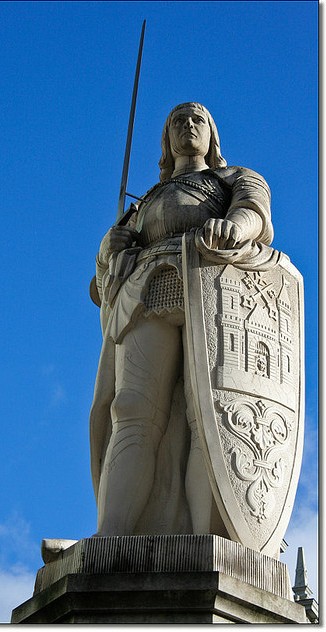
Roland de Roncevaux. The statue of Roland, is located in the centre of the town hall square in front of the House of Blackheads in Riga, Latvia. Photo by Patrick Mayon
The episode of the invasion of Spain comes next in chronological order. The condition of the venerable Iberian Church, still suffering under Moslem domination, appealed strongly to the king’s sympathy. In 777 there came to Paderborn three Moorish emirs, enemies of the Ommeyad Abderrahman, the Moorish King of Cordova. These emirs did homage to Charles and proposed to him an invasion of Northern Spain; one of the, Ibn-el-Arabi, promised to bring to the invaders’ assistance a force of Berber auxiliaries from Africa; the other two promised to exert their powerful influence at Barcelona and elsewhere north of the Ebro. Accordingly, in the spring of 778, Charles, with a host of crusaders, speaking many tongues, and which numbered among its constituents even a quota of Lombards, moved towards the Pyrenees. His trusted lieutenant, Duke Bernhard, with one division, entered Spain by the coast. Charles himself marched through the mountain passes straight to Pampelona. But Ibn-el-Arabi, who had prematurely brought on his army of Berbers, was assassinated by the emissary of Abderrahman, and though Pampelona was razed, and Barcelona and other cities fell, Saragossa held out. Apart from the moral effect of this campaign upon the Moslem rulers of Spain, its result was insignificant, though the famous ambuscade in which perished Roland, the great Paladin, at the Pass of Roncesvalles, furnished to the medieval world the material for its most glorious and influential epic, the “Chanson de Roland”.
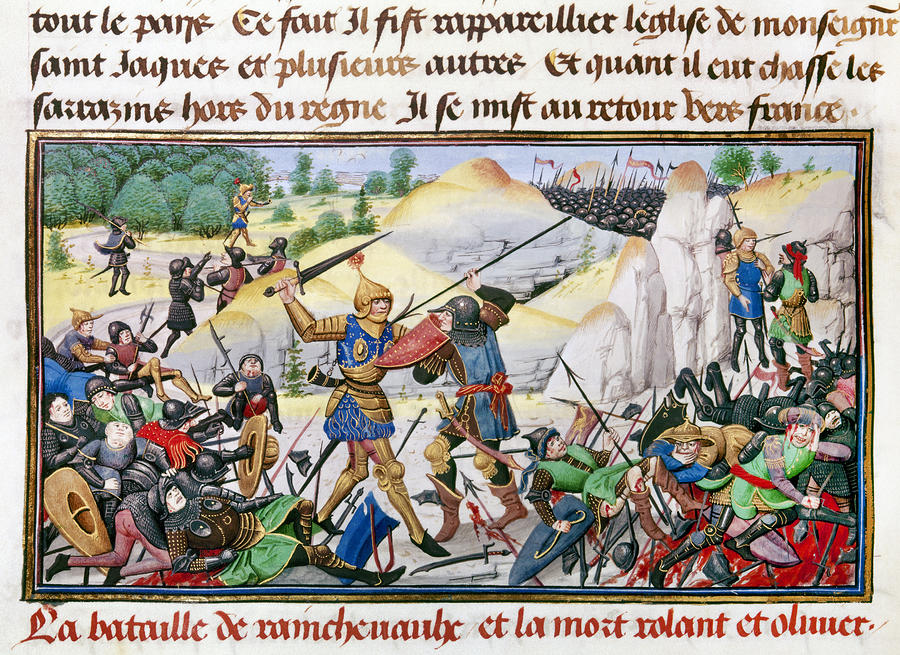
SONG OF ROLAND, 778 A.D. The death of Roland (in gold armor), the nephew of Charlemagne and the most celebrated of the emperor's twelve paladins, at the Battle of Roncesvalles in the Pyrenees, 778 A.D., the basis of the epic 'Chanson de Roland.' Flemish manuscript illumination, 1462.
Much more important to posterity were the next succeeding events which continued and decided the long struggle in Saxony. During the Spanish crusade Wittekind had returned from his exile, bringing with him Danish allies, and was now ravaging Hesse; the Rhine valley from Deutz to Andenach was a prey to the Saxon “devil-worshipers”; the Christian missionaries were scattered or in hiding. Charles gathered his hosts at Düren, in June, 779, and stormed Wittekind’s entrenched camp at Bocholt, after which campaign he seems to have considered Saxony a fairly subdued country. At any rate, the “Saxon Capitulary” of 781 obliged all Saxons not only to accept baptism (and this on the pain of death) but also to pay tithes, as the Franks did for the support of the Church; moreover it confiscated a large amount of property for the benefit of the missions. This was Wittekind’s last opportunity to restore the national independence and paganism; his people, exasperated against the Franks and their God, eagerly rushed to arms. At Suntal on the Weser, Charles being absent, they defeated a Frankish army killing two royal legates and five Counts. But Wittekind committed the error of enlisting as allies the non-Teutonic Sorbs from beyond the Saale; race-antagonism soon weakened his forces, and the Saxon hosts melted away. Of the so-called “Massacre of Verdun” (783) it is fair to say that the 4500 Saxons who perished were not prisoners of war; legally, they were ringleaders in a rebellion, selected as such from a number of their fellow rebels. Wittekind himself escaped beyond the Elbe. It was not until after another defeat of the Saxons at Detmold, and again at Osnabrück, on the “Hill of Slaughter”, that Wittekind acknowledged the God of Charles the stronger than Odin. In 785 Wittekind received baptism at Attigny, and Charles stood godfather.
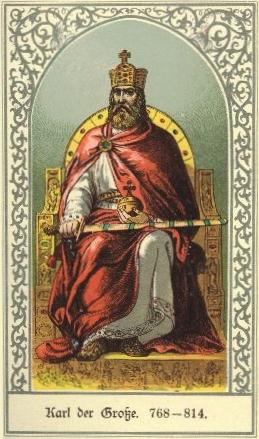
Charles' nature was of a type that appears to best advantage in storm and stress.
Last Steps to the Imperial Throne (785-800)
The summer of 783 began a new period in the life of Charles, in which signs begin to appear of his less amiable traits. It was in this year, signalized, according to the chroniclers, by unexampled heat and a pestilence, that the two queens died, Bertha, the king’s mother, and Hildegarde, his second (or his third) wife. Both of these women, the former in particular, had exercised over him a strong influence for good. Within a few months the king married Fastrada, daughter of an Austrasian count. The succeeding years were, comparatively speaking, years of harvest after the stupendous period of ploughing and sowing that had gone before; and Charles’ nature was of a type that appears to best advantage in storm and stress. What was to be the Western Empire of the Middle Ages was already hewn out in the rough when Wittekind received baptism. From that date until the coronation of Charles at Rome, in 800, his military work was chiefly in suppressing risings of the newly conquered or quelling the discontents of jealous subject princes. Thrice in these fifteen years did the Saxons rise, only to be defeated. Tassilo, Duke of Bavaria, had been a more or less rebellious vassal ever since the beginning of his reign, and Charles now made use of the pope’s influence, exercised through the powerful bishops of Freising, Salzburg, and Regensburg (Ratisbon), to bring him to terms. In 786 a Thuringian revolt was quelled by the timely death, blinding, and banishment of its leaders. Next year the Lombard prince, Areghis, having fortified himself at Salerno, had actually been crowned King of the Lombards when Charles descended upon him at Beneventum, received his submission, and took his son Grimwald as a hostage, after which, finding that Tassilo had been secretly associated with the conspiracy of the Lombards, he invaded Bavaria from three sides with three armies drawn from at least five nationalities. Once more the influence of the Holy See settled the Bavarian question in Charles’ favour; Adrian threatened Tassilo with excommunication if he persisted in rebellion, and as the Duke’s own subjects refused to follow him to the field, he personally made submission, did homage, and in return received from Charles a new lease of his duchy (October, 787).
During this period the national discontent with Fastrada culminated in a plot in which Pepin the Hunchback, Charles’ son by Himiltrude, was implicated, and though his life was spared through his father’s intercession, Pepin spent what remained of his days in a monastery. Another son of Charles (Carloman, afterwards called Pepin, and crowned King of Lombardy at Rome in 781, on the occasion of an Easter visit by the king, at which time also his brother Louis was crowned King of Aquitaine) served his father in dealing with the Avars, a pagan danger on the frontier, compared with which the invasion of Septimania by the Saracens (793) was but an insignificant incident of border warfare. These Avars, probably of Turanian blood, occupied the territories north of the Save and west of the Theiss. Tassilo had invited their assistance against his overlord; and after the Duke’s final submission Charles invaded their country and conquered it as far as the Raab (791). By the capture of the famous “Ring” of the Avars, with its nine concentric circles, Charles came into possession of vast quantities of gold and silver, parts of the plunder which these barbarians had been accumulating for two centuries. In this campaign King Pepin of Lombardy cooperated with his father, with forces drawn from Italy; the later stages of this war (which may be considered the last of Charles’ great wars) were left in the hands of the younger king.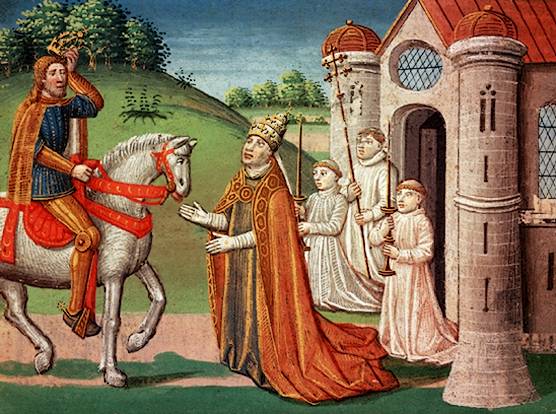
The last stages by which the story of Charles’ career is brought to its climax touch upon the exclusive spiritual domain of the Church. He had never ceased to interest himself in the deliberations of synods, and this interest extended (an example that wrought fatal results in after ages) to the discussion of questions which would now be regarded as purely dogmatic. Charles interfered in the dispute about the Adoptionist heresy. His interference was less pleasing to Adrian in the matter of Iconoclasm, a heresy with which the Empress-mother Irene and Tarasius, Patriarch of Constantinople, had dealt in the second Council of Nicaea. The Synod of Frankfort, wrongly informed, but inspired by Charles, took upon itself to condemn the aforesaid Council, although the latter had the sanction of the Holy See. In the year 797 the Eastern Emperor Constantine VI, with whom his mother Irene had for some time been at variance, was by her dethroned, imprisoned, and blinded. It is significant of Charles’ position as de factoEmperor of the West that Irene sent envoys to Aachen to lay before Charles her side of this horrible story. It is also to be noted that the popular impression that Constantine had been put to death, and the aversion to committing the imperial sceptre to a woman’s hand, also bore upon what followed. Lastly, it was to Charles alone that the Christians of the East were now crying out for succour against the threatening advance of the Moslem Caliph Haroun al Raschid. In 795 Adrian I died (25 Dec.), deeply regretted by Charles, who held this pope in great esteem and caused a Latin metrical epitaph to be prepared for the papal tomb. In 787 Charles had visited Rome for the third time in the interest of the pope and his secure possession of the Patrimony of Peter.
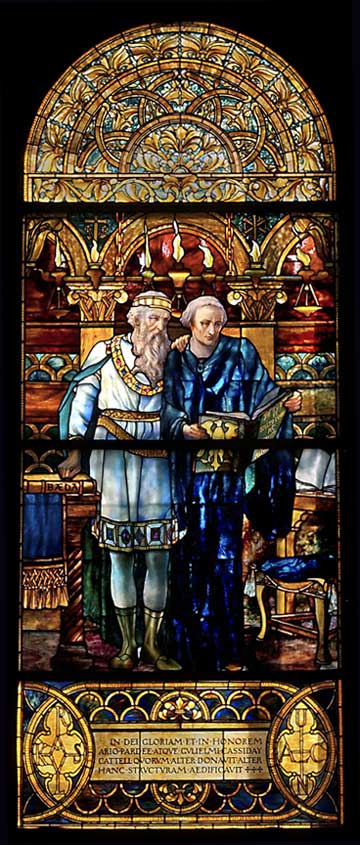
Charlemagne and Alcuin
Leo III, the immediate successor of Adrian I, notified Charles of his election (26 December, 795) to the Holy See. The king sent in return rich presents by Abbot Angilbert, whom he commissioned to deal with the pope in all manners pertaining to the royal office of Roman Patrician. While this letter is respectful and even affectionate, it also exhibits Charles’ concept of the coordination of the spiritual and temporal powers, nor does he hesitate to remind the pope of his grave spiritual obligations. The new pope, a Roman, had bitter enemies in the Eternal City, who spread the most damaging reports of his previous life. At length (25 April, 799) he was waylaid, and left unconscious. After escaping to St. Peter’s he was rescued by two of the king’s missi, who came with a considerable force. The Duke of Spoleto sheltered the fugitive pope, who went later to Paderborn, where the king’s camp then was. Charles received the Vicar of Christ with all due reverence. Leo was sent back to Rome escorted by royal missi; the insurgents, thoroughly frightened and unable to convince Charles of the pope’s iniquity, surrendered, and the missi sent Paschalis and Campulus, nephews of Adrian I and ringleaders against Pope Leo, to the king, to be dealt with at the royal pleasure.
Charles was in no hurry to take final action in this matter. He settled various affairs connected with the frontier beyond the Elbe, with the protection of the Balearic Isles against the Saracens, and of Northern Gaul against Scandinavian sea-rovers, spent most of the winter at Aachen, and was at St. Riquier for Easter. About this time, too, he was occupied at the deathbed of Liutgarde, the queen whom he had married on the death of Fastrada (794). At Tours he conferred with Alcuin, then summoned the host of the Franks to meet at Mainz and announced to them his intention of again proceeding to Rome. Entering Italy by the Brenner Pass, he travelled by way of Ancona and Perugia to Nomentum, where Pope Leo met him and the two entered Rome together. A synod was held and the charges against Leo pronounced false. On this occasion the Frankish bishops declared themselves unauthorized to pass judgment on the Apostolic See. Of his own free will Leo, under oath, declared publicly in St. Peter’s that he was innocent of the charges brought against him. Leo requested that his accusers, now themselves condemned to death, should be punished only with banishment.
After His Coronation in Rome (800-814)
Two days later (Christmas Day, 800) took place the principal event in the life of Charles. During the pontifical Mass celebrated by the pope, as the king knelt in prayer before the high altar beneath which lay the bodies of Sts. Peter and Paul, the pope approached him, placed upon his head the imperial crown, did him formal reverence after the ancient manner, saluted him as Emperor and Augustus and anointed him, while the Romans present burst out with the acclamation, thrice repeated: “To Carolus Augustus crowned by God, mighty and pacific emperor, be life and victory” (Carolo, piisimo Augusto a Deo coronato, magno et pacificio Imperatori, vita et vicotria). These details are gathered from contemporary accounts (Life of Leo III in “lib. Pont.”; “Annales Laurissense majores”; Einhard’s Vita Caroli; Theophanes). Though not all are found in any one narrative, there is no good reason for doubting their general accuracy. Einhard’s statement (Vita Caroli28) that Charles had no suspicion of what was about to happen, and if pre-informed would not have accepted the imperial crown, is much discussed, some seeing in it an unwillingness to imperial authority on an ecclesiastical basis, others more justly a natural hesitation before a momentous step overcome by the positive action of friends and admirers, and culminating; in the scene just described.
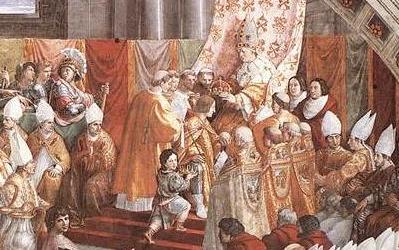
Charlemagne crowned Holy Roman Emperor
On the other hand, there seems no reason to doubt that for some time previous the elevation of Charles had been discussed, both at home and at Rome, especially in view of two facts: the scandalous condition of the imperial government at Constantinople, and the acknowledged grandeur and solidity of the Carolingian house. He owed his elevation not to the conquest of Rome, nor to any act of the Roman Senate (then a mere municipal body), much less to the local citizenship of Rome, but to the pope, who exercised in a supreme juncture the moral supremacy in Western Christendom which the age widely recognized in him, and to which, indeed, Charles even then owed the title that the popes had transferred to his father Pepin. It is certain that Charles constantly attributed his imperial dignity to an act of God, made known of course through the agency of the Vicar of Christ (divino nutu coronatus, a Deo coronatus, in “Capitularia”, ed. Baluze, I, 247, 341, 345); also that after the ceremony he made very rich gifts to the Basilica of St. Peter, and that on the same day the pope anointed (as King of the Franks) the younger Charles, son of the emperor and at that time probably destined to succeed in the imperial dignity.
The Roman Empire (Imperium Romanum), since 476 practically extinguished in the West, save for a brief interval in the sixth century, was restored by this papal act, which became the historical basis of the future relations between the popes and the successors of Charlemagne (throughout the Middle Ages no Western Emperor was considered legitimate unless he had been crowned and anointed at Rome by the successor of St. Peter). Despite the earlier goodwill and help of the papacy, the Emperor of Constantinople, legitimate heir of the imperial title (he still called himself Roman Emperor, and his capital was officially New Rome) had long proved incapable of preserving his authority in the Italian peninsula. Palace revolutions and heresy, not to speak of fiscal oppression, racial antipathy, and impotent but vicious intrigues, made him odious to the Romans and Italians generally. In any case, since the Donation of Pepin (752) the pope was formally sovereign of the duchy of Rome and the Exarchate; hence, apart from its effect on his shadowy claim to the sovereignty of all Italy, the Byzantine ruler had nothing to lose by the elevation of Charles. However, the event of Christmas Day, 800, was long resented at Constantinople, where eventually the successor of Charles was occasionally called “Emperor”, or “Emperor of the Franks”, but never “Roman Emperor”. Suffice it to add here that while the imperial consecration made him in theory, what he was already in fact, the principal ruler of the West, and impropriated, as it were, in the Carolingian line the majesty of ancient Rome, it also lifted Charles at once to the dignity of supreme temporal protector of Western Christendom and in particular of its head, the Roman Church. Nor did this mean only the local welfare of the papacy, the good order and peace of the Patrimony of Peter. It meant also, in face of the yet vast pagan world (barbarae nationes) of the North and the Southeast, a religious responsibility, encouragement and protection of missions, advancement of Christian culture, organization of dioceses, enforcement of a Christian discipline of life, improvement of the clergy, in a word, all the forms of governmental cooperation with the Church that we meet with in the life and the legislation of Charles.

Signature of Charlemagne
Long before this event Pope Adrian I had conferred (774) on Charles his father’s dignity of Patricius Romanus, which implied primarily the protection of the Roman Church in all its rights and privileges, above all in the temporal authority which it had gradually acquired (notably in the former Byzantine Duchy of Rome and the Exarchate of Ravenna) by just titles in the course of the two preceding centuries. Charles, it is true, after his imperial consecration exercised practically at Rome his authority as Patricius, or protector of the Roman Church. But he did this with all due recognition of the papal sovereignty and principally to prevent the quasi-anarchy which local intrigues and passions, family interests and ambitions, and adverse Byzantine agencies were promoting. It would be unhistorical to maintain that as emperor he ignored at once the civil sovereignty of the pope in the Patrimony of Peter. This (the Duchy of Rome and the Exarchate) he significantly omitted from the partition of the Frankish State made at the Diet of Thionville, in 806. It is to be noted that in this public division of his estate he made no provision for the imperial title, also that he committed to all three sons “the defence and protection of the Roman Church”. In 817 Louis the Pious, by a famous charter whose substantial authenticity there is no good reason to doubt, confirmed to Pope Paschal and his successors forever, “the city of Rome with its duchy and dependencies, as the same have been held to this day by your predecessors, under their authority and jurisdiction”, adding that he did not pretend to any jurisdiction in said territory, except when solicited thereto by the pope. It may be noted here that the chroniclers of the ninth century treat as “restitution” to St. Peter the various cessions and grants of cities and territory made at this period by the Carolingian rulers within the limits of the Patrimony of Peter. The Charter of Louis the Pious was afterwards confirmed by Emperor Otto I in 962 and Henry II in 1020. These imperial documents make it clear that the acts of authority exercised by the new emperor in the Patrimony of Peter were only such as were called for by his office of Defender of the Roman Church. Kleinclausz (l’Empire carolingien, etc., Paris, 1902, 441 sqq.) denies the authenticity of the famous letter (871) of Emperor Louis II to the Greek Emperor Basil (in which the former recognizes fully the papal origin of his own imperial dignity), and attributes it to Anastasius Bibliotheca in 879. His arguments are weak; the authenticity is admitted by Gregorovius and O. Harnack. Anti-papal writers have undertaken to prove that Charles’ dignity of Patricius Romanorum was equivalent to immediate and sole sovereign authority at Rome, and in law and in fact excluded any papal sovereignty. In reality this Roman patriciate, both under Pepin and Charles, was no more than a high protectorship of the civil sovereignty of the pope, whose local independence, both before and after the coronation of Charles, is historically certain, even apart from the aforesaid imperial charters.
The personal devotion of Charles to the Apostolic See is well known. While in the preface to his Capitularies he calls himself the “devoted defender and humble helper of Holy Church”, he was especially fond of the basilica of St. Peter at Rome. Einhard relates (Vita, c. xxvii) that he enriched it beyond all other churches and that he was particularly anxious that the City of Rome should in his reign obtain again its ancient authority. He promulgated a special law on the respect due this See of Peter (Capitulare de honoranda sede Apostolica, ed. Baluze I, 255). The letters of the popes to himself, his father, and grandfather, were collected by his order in the famous “Codex Carolinus”. Gregory VII tells us (Regest., VII, 23) that he placed a part of the conquered Saxon territory under the protection of St. Peter, and sent to Rome a tribute from the same. He received from Pope Adrian the Roman canon law in the shape of the “Collectio Dionysia-Hadriana”, and also (784-91) the “Gregorian Sacramentary” or liturgical use of Rome, for the guidance of the Frankish Church. He furthered also in the Frankish churches the introduction of the Gregorian chant. It is of interest to note that just before his coronation at Rome Charles received three messengers from the Patriarch of Jerusalem, bearing to the King of the Franks the keys of the Holy Sepulchre and the banner of Jerusalem, “a recognition that the holiest place in Christendom was under the protection of the great monarch of the West” (Hodgkin). Shortly after this event, the Caliph Haroun al Raschid sent an embassy to Charles, who continued to take a deep interest in the Holy Sepulchre, and built Latin monasteries at Jerusalem, also a hospital for pilgrims. To the same period belongs the foundation of the Schola Francorumnear St. Peter’s Basilica, a refuge and hospital (with cemetery attached) for Frankish pilgrims to Rome, now represented by the Campo Santo de’ Tedeschi near the Vatican.
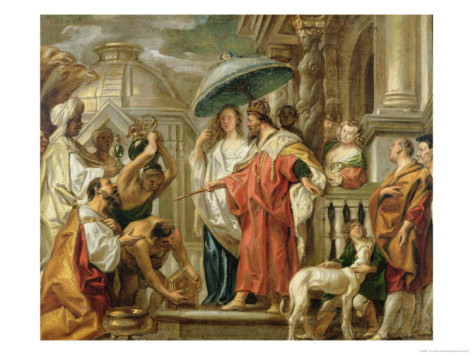
Homage of Caliph Harun Al-Rashid to Charlemagne
The main work of Charlemagne in the development of Western Christendom might have been considered accomplished had he now passed away. Of all that he added during the remaining thirteen years of his life nothing increased perceptibly the stability of the structure. His military power and his instinct for organization had been successfully applied to the formation of a material power pledged to the support of the papacy, and on the other hand at least one pope (Adrian) had lent all the spiritual strength of the Holy See to help build up the new Western Empire, which his immediate successor (Leo) was to solemnly consecrate. Indeed, the remaining thirteen years of Charles’ earthly career seem to illustrate rather the drawbacks of an intimate connection between Church and State than its advantages.
In those years nothing like the military activity of the emperor’s earlier life appears; there were much fewer enemies to conquer. Charles’ sons led here and there an expedition, as when Louis captured Barcelona (801) or the younger Charles invaded the territory of the Sorbs. But their father had somewhat larger business on his hands at this time; above all, he had to either conciliate or neutralize the jealousy of the Byzantine Empire which still had the prestige of old tradition. At Rome Charles had been hailed in due form as “Augustus” by the Roman people, but he could not help realizing that many centuries before, the right of conferring this title had virtually passed from Old to New Rome. New Rome, i.e. Constantinople, affected to regard Leo’s act as one of schism. Nicephorus, the successor of Irene (803) entered into diplomatic relations with Charles, it is true, but would not recognize his imperial character. According to one account (Theophanes) Charles had sought Irene in marriage, but his plan was defeated. The Frankish emperor then took up the cause of rebellious Venetia and Dalmatia. The war was carried on by sea, under King Pepin, and in 812, after the death of Nicephorus, a Byzantine embassy at Aachen actually addressed Charles as Basileus. About this time Charles again trenched upon the teaching prerogative of the Church, in the matter of the although in this instance also the Holy See admitted the soundness of his doctrine, while condemning his usurpation of its functions.
The other source of discord which appeared in the new Western Empire, and from its very beginning, was that of the succession. Charles made no pretence either of right of primogeniture for his eldest son or to name a successor for himself. As Pepin the Short had divided the Frankish realm, so did Charles divide the empire among his sons, naming none of them emperor. By the will which he made in 806 the greater part of what was later called France went to Louis the Pious; Frankland proper, Frisia, Saxony, Hesse, and Franconia were to be the heritage of Charles the Young; Pepin received Lombardy and its Italian dependencies, Bavaria, and Southern Alemannia. But Pepin and Charles pre-deceased the emperor, and in 813 the magnates of the empire did homage at Aachen to Louis the Pious as King of the Franks, and future sole ruler of the great imperial state. Thus is was that the Carolingian Empire, as a dynastic institution, ended with the death of Charles the Fat (888), while the Holy Roman Empire, continued by Otto the Great (968-973), lacked all that is now France. But the idea of a Europe welded together out of various races under the spiritual influence of one Catholic Faith and one Vicar of Christ had been exhibited in the concrete.
It remains to say something of the achievements of Charlemagne at home. His life was so full of movement, so made up of long journeys, that home in his case signifies little more than the personal environment of his court, wherever it might happen to be on any given day. There was, it is true, a general preference for Austrasia, or Frankland (after Aachen, Worms, Nymwegen, and Ingleheim were favourite residences). He took a deep and intelligent interest in the agricultural development of the realm, and in the growth of trade, both domestic and foreign. The civil legislative work of Charles consisted principally in organizing and codifying the principles of Frankish law handed down from antiquity; thus in 802 the laws of the Frisians, Thuringians, and Saxons were reduced to writing. Among these principles, it is important to note, was one by which no free man could be deprived of life or liberty without the judgment of his equals in the state. The spirit of his legislation was above all religious; he recognized as a basis and norm the ecclesiastical canons, was wont to submit his projects of law to the bishops, or to give civil authority to the decrees of synods. More than once he made laws at the suggestion of popes or bishops. For administrative purposes the State was divided into counties and hundreds, for the government of which counts and hundred-men were responsible. Side by side with the counts in the great national parliament (Reichstag, Diet) which normally met in the spring, sat the bishops, and the spiritual constituency was so closely intertwined with the temporal that in reading of a “council” under Charles, it is not always easy to ascertain whether the particular proceedings are supposed to be those of a parliament or of a synod. Nevertheless this parliament or diet was essentially bicameral (civil and ecclesiastical), and the foregoing descriptions applies to the mutual discussion of res mixtaeor subjects pertaining to both orders.

Charlemagne Presiding at the School of the Palace
The one Frankish administrative institution to which Charles gave an entirely new character was the missi dominici, representatives (civil and ecclesiastical) of the royal authority, who from being royal messengers assumed under him functions much like those of papal legates, i.e. they were partly royal commissioners, partly itinerant governors. There were usually two for each province (an ecclesiastic and a lay lord), and they were bound to visit their territory (missatica) four times each year. Between these missi and the local governors or counts the power of the former great crown-vassals (dukes, Herzöge) was parcelled out. Local justice was administered by the aforesaid count (comes, Graf) in his court, held three times each year (placitum generale), with the aid of seven assessors (scabini, rachimburgi), but there was a graduated appeal ending in the person of the emperor.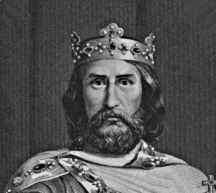
While enough has been said above to show how ready he was to interfere in the Church’s domain, it does not appear that this propensity arose from motives discreditable to his religious character. It would be absurd to pretend that Charlemagne was a consistent lifelong hypocrite; if he was not, then his keen practical interest in all that pertained to the services of the Church, his participation even in the chanting of the choir (though, as his biographer says, “in a subdued voice”) his fastidious attention to questions of rites and ceremonies (Monachus Sangallensis), go to show, like many other traits related of him, that his strong rough nature was really impregnated with zeal, however mistaken at times, for the earthly glory of God. He sought to elevate and perfect the clergy, both monastic and secular, the latter through the enforcement of the Vita Canonicaor common life. Tithes were strictly enforced for the support of the clergy and the dignity of public worship. Ecclesiastical immunities were recognized and protected, the bishops held to frequent visitation of their dioceses, a regular religious instruction of the people provided for, and in the vernacular tongue. Through Alcuin he caused corrected copies of the Scripture to be placed in the churches, and earned great credit for his improvement of the much depraved text of the Latin Vulgate. Education, for aspirants to the priesthood at least, was furthered by the royal order of 787 to all bishops and abbots to keep open in their cathedrals and monasteries schools for the study of the seven liberal arts and the interpretation of Scriptures. He did much also to improve ecclesiastical music, and founded schools of church-song at Metz, Soissons, and St. Gall.
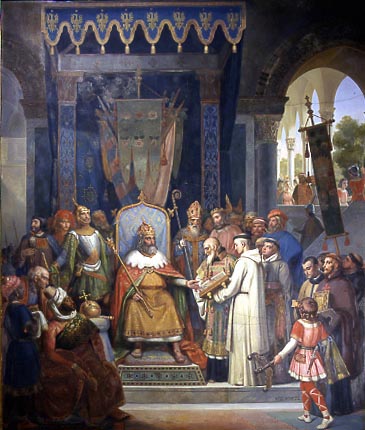
Charlemagne and Alcuin
He spoke Latin well, and loved to listen to the reading of St. Augustine, especially “The City of God”. He understood Greek, but was especially devoted to his Frankish (Old-German) mother tongue; its terms for the months and the various winds are owing to him. He attempted also to produce a German grammar, and Einhard tells us that he caused the ancient folksongs and hero-tales (barbara atque antiquissima carmina) to be collected; unfortunately this collection ceased to be appreciated and was lost at a later date.
From boyhood Charles had evinced strong domestic affections. Judged, perhaps, by the more perfectly developed Christian standards of a later day, his matrimonial relations were far from blameless; but it would be unfair to criticize by any such ethical rules the obscurely transmitted accounts of his domestic life which have come down to us. What is certain (and more pleasant to contemplate) is the picture, which his contemporaries have left us, of the delight he found in being with his children, joining in their sports, particularly in his own favourite recreation of swimming, and finding his relaxation in the society of his sons and daughters; the latter he refused to give in marriage, unfortunately for their moral character. He died in his seventy-second year, after forty-seven years of reign, and was buried in the octagonal Byzantine-Romanesque church at Aachen, built by him and decorated with marble columns from Rome and Ravenna.
In the year 1000 Otto III opened the imperial tomb and found (it is said) the great emperor as he had been buried, sitting on a marble throne, robed and crowned as in life, the book of the Gospels open on his knees.
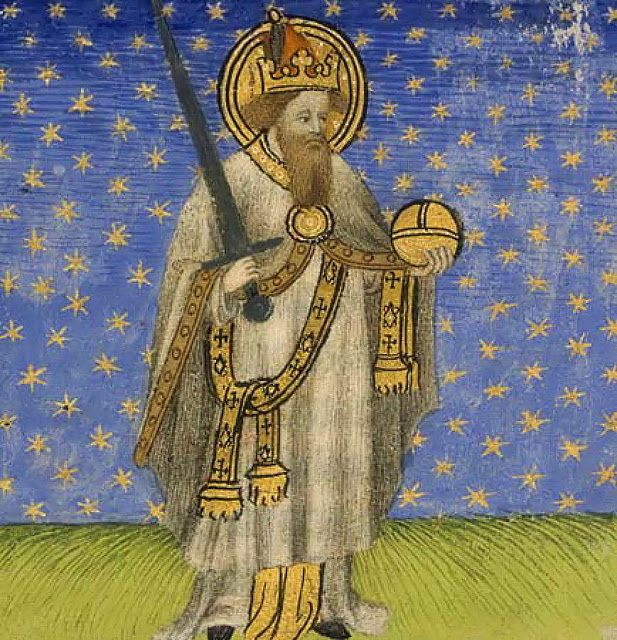
Charlemagne with the halo of holiness
In some parts of the empire popular affection placed him among the saints. For political purposes and to please Frederick Barbarossa he was canonized (1165) by the antipope Paschal III, but this act was never ratified by insertion of his feast in the Roman Breviary or by the Universal Church; his cultus, however, was permitted at Aachen [Acta SS., 28 Jan., 3d ed., II, 490-93, 303-7, 769; his office is in Canisius, "Antiq. Lect.", III (2)].
According to his friend and biographer, Einhard, Charles was of imposing stature, to which his bright eyes and long, flowing hair added more dignity. His neck was rather short, and his belly prominent, but the symmetry of his other members concealed these defects. His clear voice was not so sonorous as his gigantic frame would suggest. Except on his visits to Rome he wore the national dress of his Frankish people, linen shirt and drawers, a tunic held by a silken cord, and leggings; his thighs were wound round with thongs of leather; his feet were covered with laced shoes. He had good health to his sixty-eighth year, when fevers set in, and he began to limp with one foot. He was his own physician, we are told, and much disliked his medical advisers who wished him to eat boiled meat instead of roast. No contemporary portrait of him has been preserved. A statuette in the Musée Carnavalet at Paris is said to be very ancient.
THOMAS J. SHAHAN & E. MACPHERSON (1913 Catholic Encyclopedia)


